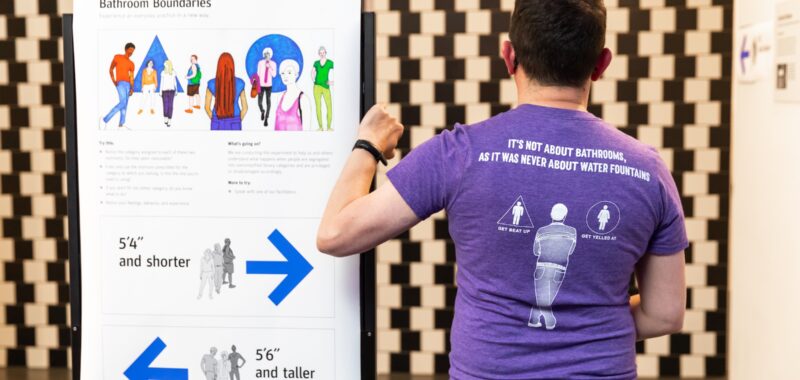From art institutions to science centers, museums often cite inclusion and community in their mission statements. But one critical facility is regularly neglected: all-gender restrooms.
“The museum’s values state a commitment to being inclusive, imaginative, and caring,” Esme Ward, director of the Manchester Museum in England, told Hyperallergic. “If we’re really serious about extending that care, we need to have all-gender toilets.”
As trans rights come under attack in the United States and worldwide, high-profile institutions have received attention for accommodating trans and nonbinary visitors. In 2014, the Whitney Museum of American Art in New York announced its new all-gender bathrooms, and the Baltimore Art Museum’s all-gender restrooms named for artist John Waters made headlines in 2021. Hyperallergic spoke to seven museum professionals, many of them queer and trans individuals who use all-gender toilets themselves, about the labor and expertise that goes into developing these facilities.

Right: Restroom signage at the Burrell Collection in Glasgow rejects the gender binary by using an icon of a toilet. (photo Margaret Middleton/Hyperallergic)
The Manchester Museum team took a collaborative, community-focused approach to developing all-gender toilets. While the institution closed for redevelopment in 2022, Learning Facilitator and Visitor Team Coordinator Mattie Davies ran a focus group with The Proud Trust, a local LGBTQ+ youth organization. Together, they decided on signage iconography that emphasizes the facility rather than the user, opting for a toilet symbol in place of the typical gendered silhouettes.
The museum’s new restrooms don’t just appeal to trans and gender-nonconforming visitors, though, Davies told Hyperallergic. They also feature baby-changing spaces and three different types of accessible toilets, including a “Changing Places” toilet, equipped with a full-size changing bench and hoist so people with limited mobility can use the restroom or have their continence pad changed.
“By combining these facilities under the All-Gender Toilets, visitors and families of any combination of disabled, neurodivergent, trans, and nonbinary identities can use the same facilities,” Davies explained.

All-gender restroom facilities are often included in museum access guides alongside information about wheelchair access, service animals, breastfeeding, and sensory needs. Davies added that “toilets with their own sinks in particular might be preferred by visitors with a range of needs, whether that is to wash out a menstrual cup or to avoid sensory overload from hand dryers.” Manchester Museum provides a Toilet Map on their website, stating, “Whoever you are, you will find a toilet for you in the museum.”
Beyond cultivating a more welcoming space for trans and nonbinary visitors, all-gender toilets reflect a commitment to good visitor service practice. Children’s museums have long offered family restrooms, recognizing that a visit to a public bathroom is a communal affair for children and caregivers, and sex-segregated restrooms can be challenging to navigate. Peter Fallon, visitor team manager at Manchester Museum, lists the institution’s all-gender bathrooms as part of a suite of amenities, also including a picnic area and a prayer room.
According to Ward, much of the feedback on the all-gender toilets at the Manchester Museum has been positive. But when complaints arise, staff are equipped with a protocol that instructs them to inform the visitors of the museum’s values of inclusivity, imagination, and care, and then direct them to sex-segregated toilet options.

In some cases, the introduction of all-gender toilets is directly inspired by new exhibitions that prompt museum workers to consider these spaces.
Queer heritage researcher Kit Heyam worked with the Royal Armouries Museum in Leeds to produce Forgotten Battles, a 2023 exhibition and object trail highlighting stories related to gender. Heyam told Hyperallergic that, in the lead-up to this community project, they facilitated a trans awareness training for Armouries staff, which motivated the museum to turn one of the women’s restrooms into an all-gender bathroom by changing the signage. Another outcome of the project was the Gendering the Museum Toolkit, which recommends providing gender-inclusive restrooms.
Matisse DuPont, who consults on gender and sexuality in museums, advised on interpretation for the 2019 exhibition Gender Bending Fashion at the Museum of Fine Arts, Boston. DuPont told Hyperallergic that they advocated for the toilets adjacent to the gallery to be transformed into all-gender restrooms. At some point after the show closed, DuPont noticed that the restrooms had been quietly reverted, and said they went back to advocate for the restoration of the all-gender facility. Though they were ultimately successful, DuPont described the process as “emotional.”
“I hated having to fight for what feels like basic things,” DuPont said.

At San Francisco’s Exploratorium, which describes itself as a “public learning laboratory,” the instigators for change came from within. The museum was the site of a toilet “intervention” in 2018, when trans staff members Sal Bell Alper and Shafer Mazow took an experimental approach by prototyping bathroom signage designating new categories for the sex-segregated staff restrooms. One day the restrooms were divided by height; another day by eye color. As staff engaged with the experimental signage, support grew for a public-facing version.
The intervention, titled Bathroom Boundaries, problematized the convention of gendered toilet use and fostered empathy, confronting all bathroom users with the same issues many gender-nonconforming people face. Some visitors didn’t align with either toilet, while others were so close to the boundary between two categories that they questioned whether they belonged. According to Alper, the Exploratorium has yet to adopt official all-gender restrooms.
The US and UK governments have both become increasingly hostile to trans and gender nonconforming people. The Trump administration is taking deliberate steps to erase trans people from history and public life, while the Starmer ministry continues to walk back Labour Party promises of ensuring trans rights.
Museums have an opportunity to counter this climate of transphobia by taking steps to become queer inclusive, the workers Hyperallergic interviewed emphasized. Alongside exhibitions with queer content and programming, all-gender restrooms are part of actively welcoming and meeting the needs of queer visitors, as well as a range of other communities; or, as DuPont puts it: “Gender inclusivity will free all of us.”

